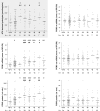Paraoxonase (PON1 and PON3) Polymorphisms: Impact on Liver Expression and Atorvastatin-Lactone Hydrolysis
- PMID: 21852972
- PMCID: PMC3147178
- DOI: 10.3389/fphar.2011.00041
Paraoxonase (PON1 and PON3) Polymorphisms: Impact on Liver Expression and Atorvastatin-Lactone Hydrolysis
Abstract
Atorvastatin δ-lactone, a major, pharmacologically inactive metabolite, has been associated with toxicity. In a previous study we showed that polymorphisms of UGT1A3 influence atorvastatin δ-lactone formation. Here we investigated the reverse reaction, atorvastatin δ-lactone hydrolysis, in a human liver bank. Screening of microarray data revealed paraoxonases PON1 and PON3 among 17 candidate esterases. Microsomal δ-lactone hydrolysis was significantly correlated to PON1 and PON3 protein (r(s) = 0.60; r(s) = 0.62, respectively; P < 0.0001). PON1 and PON3 were strongly correlated to each other (r(s) = 0.60) but PON1 was shown to be more extensively glycosylated than PON3. In addition a novel splice-variant of PON3 was identified. Genotyping of 40 polymorphisms within the PON-locus identified PON1 promoter polymorphisms (-108T > C, -832G > A, -1741G > A) and a tightly linked group of PON3 polymorphisms (-4984A > G, -4105G > A, -1091A > G, -746C > T, and F21F) to be associated with changes in atorvastatin δ-lactone hydrolysis and expression of PON1 but not PON3. However, carriers of the common PON1 polymorphisms L55M or Q192R showed no difference in δ-lactone hydrolysis or PON expression. Haplotype analysis revealed decreased δ-lactone hydrolysis in carriers of the most common haplotype *1 compared to carriers of haplotypes *2, *3, *4, and *7. Analysis of non-genetic factors showed association of hepatocellular and cholangiocellular carcinoma with decreased PON1 and PON3 expression, respectively. Increased C-reactive protein and γ-glutamyl transferase levels were associated with decreased protein expression of both enzymes, and increased bilirubin levels, cholestasis, and presurgical exposure to omeprazole or pantoprazole were related to decreased PON3 protein. In conclusion, PON-locus polymorphisms affect PON1 expression whereas non-genetic factors have an effect on PON1 and PON3 expression. This may influence response to therapy or adverse events in statin treatment.
Keywords: PON1; PON3; SNP; atorvastatin-lactone; myopathy; paraoxonase; pharmacogenetics; rhabdomyolysis.
Figures









Similar articles
-
Paraoxonase gene polymorphisms and haplotype analysis in a stroke population.BMC Med Genet. 2006 Mar 21;7:28. doi: 10.1186/1471-2350-7-28. BMC Med Genet. 2006. PMID: 16551349 Free PMC article.
-
Identification of biologically active δ-lactone eicosanoids as paraoxonase substrates.Biochem Biophys Res Commun. 2018 Oct 20;505(1):87-92. doi: 10.1016/j.bbrc.2018.09.083. Epub 2018 Sep 18. Biochem Biophys Res Commun. 2018. PMID: 30241945
-
Genetic variation in the paraoxonase-3 (PON3) gene is associated with serum PON1 activity.Ann Hum Genet. 2008 Jan;72(Pt 1):72-81. doi: 10.1111/j.1469-1809.2007.00400.x. Epub 2007 Sep 25. Ann Hum Genet. 2008. PMID: 17900266
-
Review: The role of paraoxonase in cardiovascular diseases.Ann Clin Lab Sci. 2015 Spring;45(2):226-33. Ann Clin Lab Sci. 2015. PMID: 25887882 Review.
-
Paraoxonase (PON 1) as a biomarker of susceptibility for organophosphate toxicity.Biomarkers. 2003 Jan-Feb;8(1):1-12. doi: 10.1080/13547500210148315. Biomarkers. 2003. PMID: 12519632 Review.
Cited by
-
Additional Common Polymorphisms in the PON Gene Cluster Predict PON1 Activity but Not Vascular Disease.J Lipids. 2012;2012:476316. doi: 10.1155/2012/476316. Epub 2012 May 22. J Lipids. 2012. PMID: 22685667 Free PMC article.
-
A PON for All Seasons: Comparing Paraoxonase Enzyme Substrates, Activity and Action including the Role of PON3 in Health and Disease.Antioxidants (Basel). 2022 Mar 19;11(3):590. doi: 10.3390/antiox11030590. Antioxidants (Basel). 2022. PMID: 35326240 Free PMC article. Review.
-
Population Scale Retrospective Analysis Reveals Potential Risk of Cholestasis in Pregnant Women Taking Omeprazole, Lansoprazole, and Amoxicillin.Interdiscip Sci. 2019 Jun;11(2):273-281. doi: 10.1007/s12539-019-00335-w. Epub 2019 May 20. Interdiscip Sci. 2019. PMID: 31106388 Free PMC article.
-
Regulation of Human Hydrolases and Its Implications in Pharmacokinetics and Pharmacodynamics.Drug Metab Dispos. 2024 Oct 16;52(11):1139-1151. doi: 10.1124/dmd.123.001609. Drug Metab Dispos. 2024. PMID: 38777597 Review.
-
Development, validation and application of a novel HPLC-MS/MS method for the quantification of atorvastatin, bisoprolol and clopidogrel in a large cardiovascular patient cohort.J Pharm Biomed Anal. 2018 Sep 10;159:272-281. doi: 10.1016/j.jpba.2018.06.062. Epub 2018 Jul 3. J Pharm Biomed Anal. 2018. PMID: 30005242 Free PMC article. Clinical Trial.
References
-
- Aragones G., Guardiola M., Barreda M., Marsillach J., Beltran-Debon R., Rull A., Mackness B., Mackness M., Joven J., Simo J. M., Camps J. (2011). Measurement of serum paraoxonase-3 concentration: method evaluation, reference values and influence of genotypes in a population-based study. J. Lipid Res. 52, 1055–106110.1194/jlr.D014134 - DOI - PMC - PubMed
-
- Baer A. N., Wortmann R. L. (2007). Myotoxicity associated with lipid-lowering drugs. Curr. Opin. Rheumatol. 19, 67–73 - PubMed
LinkOut - more resources
Full Text Sources
Molecular Biology Databases
Research Materials
Miscellaneous

